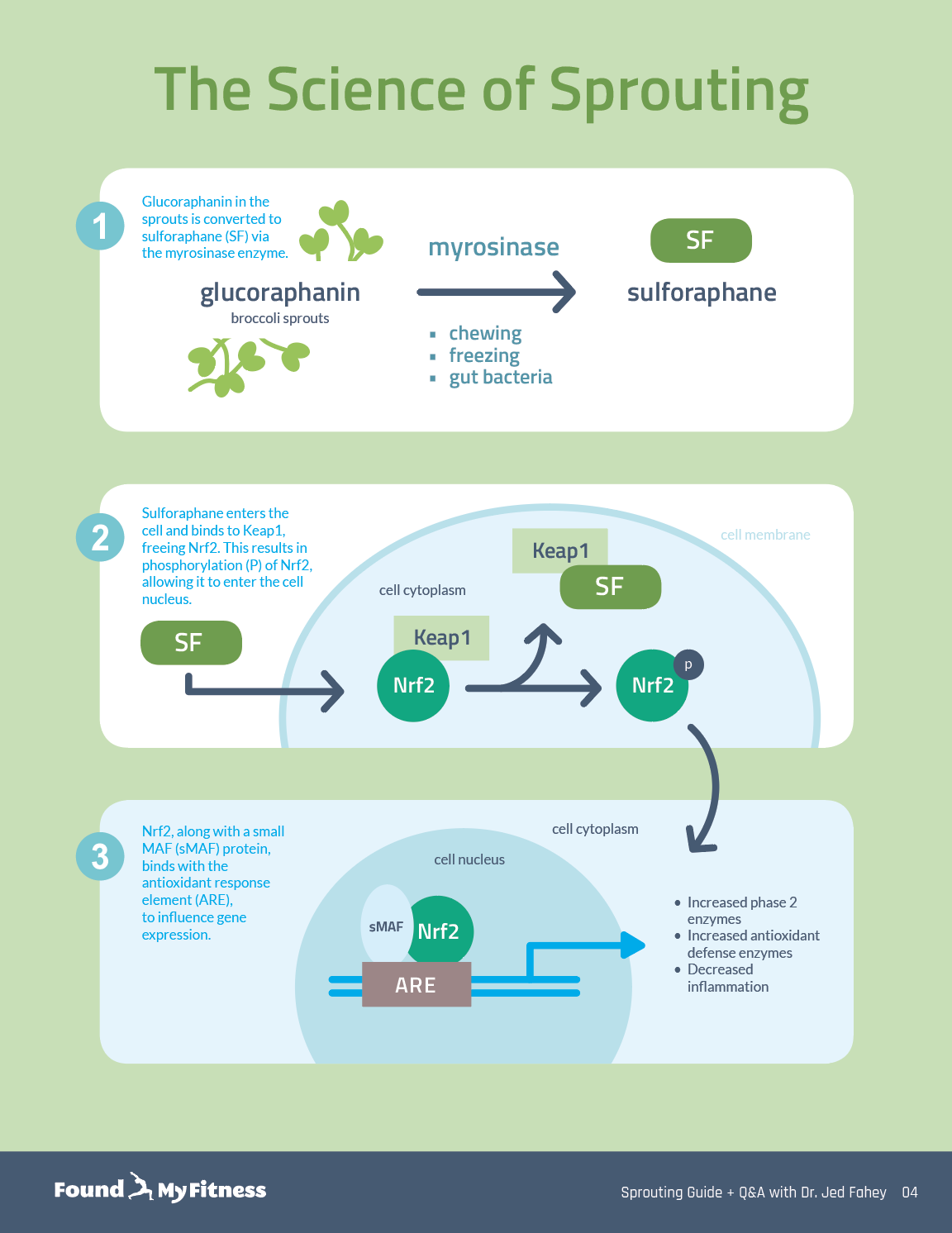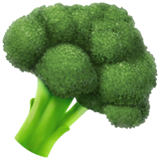STUDY: Increasing sulforaphane bioavailability from broccoli through exogenous myrosinase.
Enter your email to get our 15-page guide to sprouting broccoli and learn about the science of chemoprotective compount sulforaphane.
Broccoli sprouts are concentrated sources of sulforaphane, a type of isothiocyanate. Damaging broccoli sprouts – when chewing, chopping, or freezing – triggers an enzymatic reaction in the tiny plants that produces sulforaphane.

Sulforaphane – an isothiocyanate phytochemical derived from cruciferous vegetables like broccoli, cauliflower, and mustard – induces a wide array of protective mechanisms in cells. But sulforaphane isn’t normally present in these vegetables. Instead, it’s an end product of a chemical reaction between a precursor molecule (called glucoraphanin) and an enzyme (called myrosinase).
The chemical reaction occurs when you chop, chew, or otherwise damage the plant. Unfortunately, myrosinase is heat sensitive, so cooking inactivates it, preventing the reaction from occurring and reducing the amount of sulforaphane you get from your favorite cooked crucifers.
But findings from a new study show that adding myrosinase derived from ground raw mustard seeds to cooked crucifers increased the bioavailability of the veggies’ sulforaphane 4-fold in humans! (Although previous studies had shown similar results, they were in vitro studies.)
In this short video, Rhonda talks about the new study and suggests that if you prefer your cruciferous veggies steamed, sautéed, or roasted, this strategy might offer a way to have your cooked vegetables and get your sulforaphane, too. Just be sure the ground mustard seeds have the bitter, pungent flavor associated with isothiocyanates – a sign that the myrosinase in the mustard seed is active and working!
To learn more about sulforaphane, check out this comprehensive literature review video on isothiocyanates or this interview episode with Dr. Jed Fahey, an expert on sulforaphane and its many health benefits.
A class of edible plants from the Brassicaceae, Capparaceae, and Caricaceae families, so named for their cross-shaped flowers. Crucifers contain glucosinolates and myrosinase, which react to form isothiocyanates, a class of compounds with known beneficial health effects in humans. Cruciferous vegetables include arugula, broccoli, bok choy, Brussels sprouts, cabbage, capers, cauliflower, cress, collards, kale, kohlrabi, moringa, mustard, papaya, radish, rutabaga, turnips, wasabi, and watercress.
A glucosinolate (see definition) found in certain cruciferous vegetables, including broccoli, Brussels sprouts, and mustard. Glucoraphanin is hydrolyzed by the enzyme myrosinase to produce sulforaphane, an isothiocyanate compound that has many beneficial health effects in humans.
Plant secondary metabolites found primarily in cruciferous vegetables. Glucosinolates give rise to a variety of compounds that have been identified as potent chemoprotective agents in humans against the pathogenesis of many chronic diseases such as cancer, cardiovascular disease, and neurodegenerative disease, among others. These products are responsible for the pungent aroma, sharp flavor, and the “heat” commonly associated with some cruciferous vegetables such as wasabi and horseradish.
Byproduct of a reaction between two compounds (glucosinolates and myrosinase) that are found in cruciferous vegetables. Isothiocyanates inhibit phase I biotransformation enzymes, a class of enzymes that transform procarcinogens into their active carcinogenic state. Isothiocyanates activate phase II detoxification enzymes, a class of enzymes that play a protective role against DNA damage caused by reactive oxygen species and carcinogens. Examples of phase II enzymes include UDP-glucuronosyltransferases, sulfotransferases, N-acetyltransferases, glutathione S-transferases, and methyltransferases.
An isothiocyanate compound derived from cruciferous vegetables such as broccoli, cauliflower, and mustard. Sulforaphane is produced when the plant is damaged when attacked by insects or eaten by humans. It activates cytoprotective mechanisms within cells in a hormetic-type response. Sulforaphane has demonstrated beneficial effects against several chronic health conditions, including autism, cancer, cardiovascular disease, diabetes, and others.
Attend Monthly Q&As with Rhonda
Support our work

The FoundMyFitness Q&A happens monthly for premium members. Attend live or listen in our exclusive member-only podcast The Aliquot.
Sulforaphane News
- Broccoli seed extract with a sulforaphane precursor reduced common cold symptom days in healthy adults.
- Sulforaphane-rich broccoli sprout extract modestly lowers fasting blood sugar in some people with prediabetes, perhaps due to variations in gut microbiota and individual metabolic traits.
- Sulforaphane, derived from broccoli, activates Nrf2, mitigating age-related skin changes and boosting the antioxidant defense system in mice.
- Sulforaphane from broccoli sprouts shows promise in preventing Alzheimer's disease – boosting memory and enhancing mitochondrial function in mice.
- Breathwork enhances endogenous antioxidant enzyme activity to counter oxidative stress.




